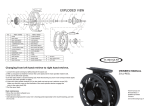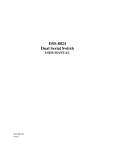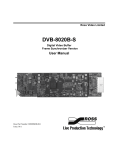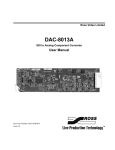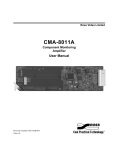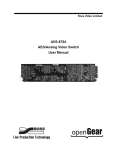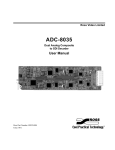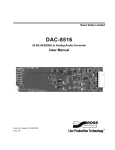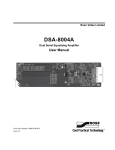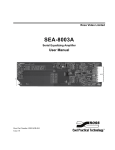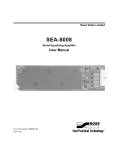Download Manual - Ross Video
Transcript
Ross Video Limited AVS-8064 AES/Analog Video Switch User Manual Ross Part Number: 8064DR-004 Issue: 05 AVS-8064 AES/Analog Video Switch User Manual • • • Ross Part Number: 8064DR-004 Document Issue: 05 Release Date: December 15, 2005. Printed in Canada. The information contained in this User Manual is subject to change without notice or obligation. Copyright © 2005 Ross Video Limited. All rights reserved. Contents of this publication may not be reproduced in any form without the written permission of Ross Video Limited. Reproduction or reverse engineering of copyrighted software is prohibited. Notice The material in this manual is furnished for informational use only. It is subject to change without notice and should not be construed as a commitment by Ross Video Limited. Ross Video Limited assumes no responsibility or liability for errors or inaccuracies that may appear in this manual. Trademarks • • • is a registered trademark of Ross Video Limited. Ross, ROSS, ROSS , and MLE are registered trademarks of Ross Video Limited. All other product names and any registered and unregistered trademarks mentioned in this manual are used for identification purposes only and remain the exclusive property of their respective owners. Important Regulatory and Safety Notices Before using this product and any associated equipment, refer to the “Important Safety Instructions” listed below so as to avoid personnel injury and to prevent product damage. Products may require specific equipment, and /or installation procedures be carried out to satisfy certain regulatory compliance requirements. Notices have been included in this publication to call attention to these Specific requirements. Symbol Meanings This symbol on the equipment refers you to important operating and maintenance (servicing) instructions within the Product Manual Documentation. Failure to heed this information may present a major risk of damage or injury to persons or equipment. Warning Caution Notice The symbol with the word “Warning” within the equipment manual indicates a potentially hazardous situation, which if not avoided, could result in death or serious injury. The symbol with the word “Caution” within the equipment manual indicates a potentially hazardous situation, which if not avoided, may result in minor or moderate injury. It may also be used to alert against unsafe practices. The symbol with the word “Notice” within the equipment manual indicates a situation, which if not avoided, may result in major or minor equipment damage or a situation which could place the equipment in a non-compliant operating state. This symbol is used to alert the user that an electrical or electronic device or assembly is susceptible to damage from an ESD event. ESD Susceptibility Important Safety Instructions Caution This product is intended to be a component product of the RossGear 8000 series frame. Refer to the RossGear 8000 series frame User Manual for important safety instructions regarding the proper installation and safe operation of the frame as well as it’s component products. Warning Certain parts of this equipment namely the power supply area still present a safety hazard, with the power switch in the OFF position. To avoid electrical shock, disconnect all A/C power cords from the chassis' rear appliance connectors before servicing this area. Warning Service barriers within this product are intended to protect the operator and service personnel from hazardous voltages. For continued safety, replace all barriers after any servicing. This product contains safety critical parts, which if incorrectly replaced may present a risk of fire or electrical shock. Components contained within the product’s power supplies and power supply area, are not intended to be customer serviced and should be returned to the factory for repair. To reduce the risk of fire, replacement fuses must be the same type and rating. Only use attachments/accessories specified by the manufacturer. EMC Notices US FCC Part 15 This equipment has been tested and found to comply with the limits for a class A Digital device, pursuant to part 15 of the FCC Rules. These limits are designed to provide reasonable protection against harmful interference when the equipment is operated in a commercial environment. This equipment generates, uses, and can radiate radio frequency energy and, if not installed and used in accordance with the instruction manual, may cause harmful interference to radio communications. Operation of this equipment in a residential area is likely to cause harmful interference in which case users will be required to correct the interference at their own expense. Changes or modifications to this equipment not expressly approved by Ross Video Ltd. could void the user’s authority to operate this equipment. Notice CANADA This Class “A” digital apparatus complies with Canadian ICES-003. Cet appareil numerique de classe “A” est conforme à la norme NMB-003 du Canada. EUROPE This equipment is in compliance with the essential requirements and other relevant provisions of CE Directive 93/68/EEC. INTERNATIONAL This equipment has been tested to CISPR 22:1997 along with amendments A1:2000 and A2:2002 and found to comply with the limits for a Class A Digital device. This is a Class A product. In domestic environments this product may cause radio interference in which case the user may have to take adequate measures. Notice Maintenance/User Serviceable Parts Routine maintenance to this RossGear product is not required. This product contains no user serviceable parts. If the module does not appear to be working properly, please contact Technical Support using the numbers listed under the “Contact Us” section on the last page of this manual. All RossGear products are covered by a generous 5-year warranty and will be repaired without charge for materials or labor within this period. See the “Warranty and Repair Policy” section in this manual for details. Environmental Information The equipment that you purchased required the extraction and use of natural resources for its production. It may contain hazardous substances that could impact health and the environment. To avoid the potential release of those substances into the environment and to diminish the need for the extraction of natural resources, Ross Video encourages you to use the appropriate take-back systems. These systems will reuse or recycle most of the materials from your end-of-life equipment in an environmentally friendly and health conscious manner. The crossed-out wheeled bin symbol invites you to use these systems. If you need more information on the collection, reuse, and recycling systems, please contact your local or regional waste administration. You can also contact Ross Video for more information on the environmental performances of our products. Contents Introduction 1-1 In This Chapter .......................................................................................................................1-1 A Word of Thanks....................................................................................................1-1 Overview ..................................................................................................................1-2 Functional Block Diagram .......................................................................................1-2 Features ....................................................................................................................1-3 Documentation Terms ..............................................................................................1-3 Installation and Setup 2-1 In This Chapter .......................................................................................................................2-1 Static Discharge........................................................................................................2-1 Unpacking ................................................................................................................2-1 Jumper Locations .....................................................................................................2-2 Board Installation .....................................................................................................2-6 BNC Labels ..............................................................................................................2-6 Cable Connections....................................................................................................2-6 LEDs.........................................................................................................................2-7 Operation 3-1 In This Chapter .......................................................................................................................3-1 GPI Operation (Level)..............................................................................................3-2 GPI Control (Edge) ..................................................................................................3-4 Remote Module Operation: ......................................................................................3-5 RCM-8120 Remote Control .....................................................................................3-6 RCM-8120-1 Remote Control..................................................................................3-9 Connecting Multiple Remote Modules To a Control Bus ......................................3-10 Specifications 4-1 In This Chapter .......................................................................................................................4-1 Technical Specifications...........................................................................................4-2 Service Information 5-1 In This Chapter .......................................................................................................................5-1 Troubleshooting Checklist .......................................................................................5-1 Warranty and Repair Policy .....................................................................................5-2 Ordering Information 6-1 In This Chapter .......................................................................................................................6-1 AVS-8064 and Related Products..............................................................................6-1 AVS-8064 User Manual (Iss. 05) Contents • i ii • Contents AVS-8064 User Manual (Iss. 05) Introduction In This Chapter This chapter contains the following information sections: • A Word of Thanks • Overview • Functional Block Diagram • Features • Documentation Terms A Word of Thanks Congratulations on choosing the Ross Video AVS-8064 AES/Analog Video Switch. The AVS-8064 is part of a full line of Digital Products within the RossGear Terminal Equipment family of products, backed by Ross Video’s experience in engineering and design expertise since 1974. You will be pleased at how easily your new AVS-8064 fits into your overall working environment. Equally pleasing is the product quality, reliability and functionality. Thank you for joining the group of worldwide satisfied Ross Video customers! Should you have a question pertaining to the installation or operation of your AVS-8064, please contact us at the numbers listed on the back cover of this manual. Our technical support staff is always available for consultation, training, or service. AVS-8064 User Manual (Iss. 05) Introduction • 1-1 Overview The AVS-8064 AES/Analog Video Switch provides a convenient and economical solution when systems require switching of analog video or digital AES/EBU audio. Each card has 4 inputs and two 4X1 crosspoints. The card can be configured for 4X2, 4X1, dual 2X1 or 2X1 operation. Each switch is controlled by an optional control module (RMC-8120 OR RMC-8120-1) or by GPI contact or logic level. All switching is done in the vertical interval, timed to an external analog color black reference, or the output of the card (composite video use only). Ross digital frames have a connection for a master reference input, which is distributed to all cards. An additional reference connector for each card is provided for use with Leitch* frames. When the Ross frame reference is used, a second output is available from the first switch. Indicator lights are provided to show the status of each crosspoint. When used with optional control module (RCM-8120 or RCM-8120-1), the last crosspoint selected will be saved to non-volatile memory for power failure protection. The AVS-8064 AES/Analog Video Switch is also compatible with Leitch 6800-series frames. Functional Block Diagram Figure 1. Simplified Block Diagram of AVS-8064 Functions * Leitch is a trademark of Leitch Technology Corporation. 1-2 • Introduction AVS-8064 User Manual (Iss. 05) Features The following features make the AVS-8064 the best solution for SDI switching: • Switches analog video or AES/EBU digital audio (per SMPTE 276M) • Can also be used with component video • 4 inputs • 2 outputs (1 per switch) • Can be configured as a 4X2 or dual 2X1 • Controllable by the RMC-8120 module or GPIs • When controlled by remote module, last crosspoint selected is saved to non-volatile memory • All switching done in the vertical interval (external analog REF or output of the switch) • Economical cost per switch • Indicators for status of each crosspoint • Fits Ross and Leitch digital frames • 5 year transferable warranty Documentation Terms The following terms are used throughout this guide: • “Frame” refers to the DFR-8104A and DFR-8110A frames that house the AVS8064 card. • All references to the DFR-8104A and DFR-8110A also include the DFR-8104A-C and DFR-8110A-C versions with the cooling fan option. See the respective User Manuals for details. • “Operator” and “User” both refer to the person who uses the AVS-8064. • “Board”, “Card”, and “Module” all refer to the AVS-8064 card itself, including all components and switches. • “System” and “Video system” refers to the mix of interconnected production and terminal equipment in which the AVS-8064 operates. AVS-8064 User Manual (Iss. 05) Introduction • 1-3 1-4 • Introduction AVS-8064 User Manual (Iss. 05) Installation and Setup In This Chapter This chapter contains the following information sections: • Static Discharge • Unpacking • Jumper Locations • Board Installation • BNC Labels • Cable Connections • User Controls • LEDs Static Discharge Whenever handling the AVS-8064 and other related equipment, please observe all static discharge precautions as described in the following note: ESD Susceptibility Static discharge can cause serious damage to sensitive semiconductor devices. Avoid handling circuit boards in high static environments such as carpeted areas, and when wearing synthetic fiber clothing. Always exercise proper grounding precautions when working on circuit boards and related equipment. Unpacking Unpack each AVS-8064 you received from the shipping container, and check the contents against the packing list to ensure that all items are included. If any items are missing or damaged, contact your sales representative or Ross Video directly. AVS-8064 User Manual (Iss. 05) Installation and Setup • 2-1 Jumper Locations Use the following discussions, the card labeling, Figure 2, and Table 2 to set up AVS-8064 jumpers. These settings are performed before installing the unit in the frame, but may be repeated as required. JP3 Board Mode JP6 SW2 Control JP8 Panel Type JP9 GPI Type JP1 JP2 Reference Clamp JP10/JP11 Ext Ref. JP4 Control JP5 Crosspoint Mode JP7 SW2 2X1 Mode Figure 2. Jumper Locations Reference Selection A sync separator provides the micro-controller with vertical rate pulses. The sync separator is fed from JP1 (Ref). If a reference is not selected, the switching point will be random. Set JP1 (Ref) as follows: • Out 1 — the reference is the output of crosspoint 1. • Out 2 — the reference is the output of crosspoint 2. • Ext — the reference is externally supplied. • No Ref — the switching point will be random. Positions Out 1 and Out 2 can only be used when the card is being used for analog composite video. The Ext and No Ref positions are for use with AES/EBU digital audio and component video. When JP1 is set to the Ext position, there are two possible sources for the external reference. These are selected with JP10 and JP11 (Ext Ref). External Reference Selection Select jumpers on both JP10 and JP11 according to your reference source: 2-2 • Installation and Setup • FRM — Frame Reference In (default setting). This position takes the switching reference from a color black signal connected to the REF connector on the frame, located near the power cord. When this mode is used, SDI Out 1B, a second output of the first switch is available on BNC 3. The FRAME position is for use only with Ross Frames. • O/P3 — BNC 3 Reference In. This position is for use with Leitch frames. AVS-8064 User Manual (Iss. 05A) Clamp There are 3 positions for JP2 (Clamp). This jumper feeds a reference voltage to the four input amps. The input amps use this reference voltage for sync tip clamping. The clamp may be set for composite video, AES/EBU audio, or RGB video. • VID — for analog composite video, the Y channel of component video, or RGB video with sync (default setting). • AES — for AES/EBU digital audio or the U, V, channels of component video. • RGB — for RGB video without sync. Board Mode JP3 Board Mode is used when the AVS-8064 is being controlled by an RCM-8120 or RCM-8120-1 module. One RCM module can control up to 10 switches (one master, 9 slaves). Select one of the following options for JP3 to choose the board mode: • Master — the AVS-8064 will be the master card (default setting). • Slave — the AVS-8064 will be a slave card. This jumper is ignored when the AVS-8064 is set for GPI control. Control JP4 Control is used to tell the card if it will be controlled by an RCM module or by GPI. Select one of the following options for JP4 to choose the control source: • Panel — the AVS-8064 will be controlled by an RCM-8120 or RCM-8120-1 remote control module (default setting). • GPI — the AVS-8064 will be controlled by a GPI. GPI Type If you set JP4 to GPI, JP9 GPI Type is used to tell the card if GPIs will be edge or level sensitive. Select one of the following options for JP9 to choose the GPI trigger type: • Level — the GPI will be level sensitive (default setting). • Edge — the GPI will be edge sensitive. Panel Type JP8 Panel Type is used to tell the card what type of control module is connected to it. This jumper is ignored when JP4 is set to GPI. Select one of the following options for JP8 to choose the control module type: • 4 Button — when connecting the card to an RCM-8120 module (default setting). • 2 Button — when connecting the card to an RCM-8120-1 module. Crosspoint Mode JP5 Xpoint Mode is used to put the card in 4X1 or 2X1 mode. Select one of the following options for JP5 to choose the crosspoint mode: • 4X1 — the card will be in 4X1 mode (default setting). • 2X1 — the card will be in 2X1 mode. AVS-8064 User Manual (Iss. 05) Installation and Setup • 2-3 Switch 2 2X1 Mode JP7 SW2 2X1 Mode is only used when JP5 is in the 2X1 position. Select one of the following options for JP7 to choose the 2X1 mode inputs: • Input 1&2 — crosspoint 2 will select between inputs 1 and 2. • Input 3&4 — crosspoint 2 will select between inputs 3 and 4 (default setting). Switch 2 Control JP6 SW2 Control allows you to slave crosspoint 2 to crosspoint 1, or have crosspoint 2 controlled by BNC 6 (Panel 2/GPI 2). Select one of the following options for JP6 to choose the 2X1 mode inputs: 2-4 • Installation and Setup • Normal — crosspoint 2 is controlled via BNC 6 GPI/Panel 2 (default setting). • Follow 1 — crosspoint 2 will track crosspoint 1. AVS-8064 User Manual (Iss. 05A) Table 1. Operating Mode Jumper Settings Operating Mode Dual 2X1 Level GPI JP5 JP4 Xpoint Control Mode GPI 2X1 JP8 Panel Type N/A JP7 JP3 SW2 SW2 2X1 Control Mode JP9 GPI Type Normal Input 3&4 Level Level Description GPI 1 (BNC 4) controls OUT 1 (selects IN 1 or IN 2) GPI 2 (BNC 6) controls OUT 2 (selects IN 3 or IN 4) GPI 1 (BNC 4) controls OUT 1 (selects IN 1 or IN 2) 2X2 Level GPI GPI 2X1 N/A Normal Input 1&2 Dual 2X1 Level GPI Tracking GPI 2X1 N/A Follow 1 Input 3&4 Level GPI 1 (BNC 4) controls OUT1 (selects IN 1 or IN 2) AND OUT 2 (selects IN 3 or IN 4) 2X1 Level GPI With 2 Outputs GPI 2X1 N/A Follow 1 Input 1&2 Level GPI 1 (BNC 4) controls OUT 1 and OUT 2 (both outputs set to the same input, either IN 1 or IN 2) Edge An edge on GPI 1 selects IN 1 for OUT 1 and IN 3 for OUT 2. An edge on GPI 2 selects IN 2 for OUT 1 and IN 4 for OUT 2. GPI 2 (BNC 6) controls OUT 2 (selects IN 1 or IN 2) 2X1 Edge GPI Tracking GPI 2X1 N/A Follow 1 Input 3&4 2X1 Edge GPI With 2 Outputs GPI 2X1 N/A Follow 1 Input 1&2 Edge An edge on GPI 1 selects IN 1 for OUT 1 and OUT 2. An edge on GPI 2 selects IN 2 for OUT 1and OUT 2. 4X1 GPI Mode GPI 4X1 N/A Follow 1 N/A Level GPI’s are binary encoded, OUT 2 tracks OUT 1. 4X2 Panel Mode Panel 4X1 4 Button Normal N/A N/A Requires 2 RCM-8120 modules. 4X1 Panel Mode Panel 4X1 4 Button Follow 1 N/A N/A Requires 1 RCM-8120 module, OUT 2 tracks OUT 1. Dual 2X1 One Panel Mode Panel 2X1 4 Button Normal As Required N/A Requires 1 RCM-8120 module. OUT 2 can be configured via JP8 to select between IN 1&2 OR IN 3&4. Dual 2X1 Two Panel Mode Panel 2X1 2 Button Normal As Required N/A Requires 2 RCM-8120-1 modules. OUT 2 can be configured via JP8 to select between IN 1&2 OR IN 3&4. 2X1 Panel With 2 Outputs Panel 2X1 2 Button Follow 1 As Required N/A Requires 1 RCM-8120-1 module. OUT 2 can be configured via JP8 to select between In 1&2 OR IN 3&4. AVS-8064 User Manual (Iss. 05) Installation and Setup • 2-5 Board Installation Use the following steps to install the AVS-8064 in a RossGear 8000 series digital distribution frame: 1. Refer to the User Manual of the RossGear 8000 series frame, to ensure that the frame is properly installed according to instructions. If this module is to be installed in any compatible frame other than a Ross Video product, refer to the frame manufacturer’s manual for specific instructions. 2. Please note that heat and power distribution requirements within a frame may dictate specific slot placement of cards. Cards with many heat-producing components should be arranged to avoid areas of excess heat build-up, particularly in frames using convectional cooling. 3. After selecting the desired frame installation slot, hold the AVS-8064 card by the edges and carefully align the card edges with the slots in the frame. Then fully insert the card into the frame until the rear connection plug is properly seated. BNC Labels Affix the supplied BNC label, as per the included instructions, to the BNC area on the rear of the rack frame. Cable Connections This section provides instructions for connecting cables to the AVS-8064 when mounted in RossGear 8000 series Digital Products Frames. The cable connectors on the rear of the frame are marked for cards having one input and eight outputs. However, the AVS-8064 has four inputs, one REF input, two outputs, and two Panel/GPI inputs. Connect the input, output, Remote Panel/GPI, and reference cables according to the frame rear panel connections diagram in the following figure. The inputs are internally terminated in 75 ohms. It is not necessary to terminate unused outputs. 2 IN In 1 In 2 2 Out 1A PNL 1/ GPI 1 PNL 2/ GPI 2 1 4 3 6 Out 1B/ Ref Out 2 5 In 3 8 In 4 7 Figure 3. BNC designations for RossGear DFR-8110A (2RU frame) Note Connector 3 is only used to connect a color black input with Leitch frames. Ross Frames use a master frame REF BNC connector that feeds the reference signal to all modules in the frame. 2-6 • Installation and Setup AVS-8064 User Manual (Iss. 05A) LEDs The front edge of the card has two sets of LED indicators, which show the status of the card inputs. They are described in the following figure and table. SW1 In 1 SW1 In 2 SW1 In 3 SW1 In 4 SW2 In SW2 In SW2 In SW2 In 1 2 3 4 Figure 4. Card Edge LEDs Table 2. LED Status Indicator Descriptions LED Color SW1 1 SW1 2 IN 1 is currently selected Yellow IN 2 is currently selected SW1 3 IN 3 is currently selected SW1 4 IN 4 is currently selected SW2 1 IN 1 is currently selected SW2 2 AVS-8064 User Manual (Iss. 05) Status Description Yellow IN 2 is currently selected SW2 3 IN 3 is currently selected SW2 4 IN 4 is currently selected Installation and Setup • 2-7 2-8 • Installation and Setup AVS-8064 User Manual (Iss. 05A) Operation In This Chapter This chapter contains the following sections: AVS-8064 User Manual (Iss. 05) • GPI Operation (Level) • GPI Operation (Edge) • Remote Module Operation • RCM-8120 Remote Control • RCM 8120-1 Remote Control • Connecting Multiple Remote Modules To a Control Bus Operation • 3-1 GPI Operation (Level) In GPI (level) mode, the card can work two ways, as a dual 2X1 switcher as a 4X1 switch. There are two GPI BNC connections. The first input of each 2X1 switch is selected while the GPI input is open. A ground or low logic level will cause the second input to be selected. GPIs are internally pulled up to +5VDC. GPI shields can be tied together. 4X1 GPI Operation When using the card in 4X1 GPI mode, the GPIs are binary encoded. Set the jumpers as follows: JP4 — GPI JP6 — Follow 1 JP5 — 4X1 JP9 — Level GPI 1 GPI 2 OUT 1 OUT 2 Open Open Short Short Open Short Open Short IN 1 IN 2 IN 3 IN 4 IN 1 IN 2 IN 3 IN 4 2X1 GPI Operation In 2X1 mode, there are 4 modes of operation: • Dual 2X1 • 2X2 • Dual 2X1 Tracking • 2X1 With 2 Outputs These modes are described below. For GPI control in 2X1 modes, the RCS-8120 is available from Ross Video. This optional module has two dual push button switches on it. It can control both GPIs on the AVS-8064. The RCS-8120 can be rack mounted with the MRP-8120 Control Panel (which can hold a total of 5 modules), or mounted in desk with the optional DCA-8120 in desk mounting adapter. Dual 2X1 Mode Set the jumpers as follows: JP4 — GPI JP6 — Normal JP5 — 2X1 JP7 — Input 3&4 JP9 — Level 3-2 • Operation GPI 1 OUT 1 GPI 2 OUT 2 Open Short IN 1 IN 2 Open Short IN 3 IN 4 AVS-8064 User Manual (Iss. 05) 2X2 Mode Set the jumpers as follows: JP4 — GPI JP6 — Normal JP5 — 2X1 JP7 — Input 1&2 JP9 — Level GPI 1 OUT 1 GPI 2 OUT 2 Open Short IN 1 IN 2 Open Short IN 1 IN 2 Dual 2X1 Tracking Mode Set the jumpers as follows: JP4 — GPI JP6 — Follow 1 JP5 — 2X1 JP7 — Input 3&4 JP9 — Level GPI 1 GPI 2 Out 1 OUT 2 Open Short Ignored Ignored IN 1 IN 2 IN 3 IN 4 2X1 Mode with 2 Outputs Set the jumpers as follows: JP4 — GPI JP6 — Follow 1 JP5 — 2X1 JP7 — Input 1&2 JP9 — Level GPI 1 GPI 2 Out 1 OUT 2 Open Short Ignored Ignored IN 1 IN 2 IN 1 IN 2 AVS-8064 User Manual (Iss. 05) Operation • 3-3 GPI Control (Edge) Edge triggering looks for a negative going edge on the GPI input. The pulse used must be at least 3 fields in duration (about 50 ms). Since a pulse is used, the best way to control equipment is with one dedicated GPI per crosspoint. This way the controlling equipment (i.e. an automation system) can always set the AVS-8064 to a known crosspoint. There are two methods to use edge triggered GPIs to control the AVS-8064. The first method is to use the GPI inputs on the RCM-8120 or RCM-8120-1 control modules with the AVS-8064 set to panel control. The control modules have four GPI inputs. This allows automation systems to control the AVS-8064, while still allowing for manual override. The remote control module MUST be active for the GPI’s to take effect. For more information on this method of edge triggered GPI control, see the RCM-8120/RCM-8120-1 owners manual. The second method is to put the AVS-8064 into edge triggered GPI mode. Since the AVS-8064 only has two GPI inputs, the card will only work in this mode when switch 2 is set to follow switch 1 (JP 3 set to FOLLOW 1). A negative going edge on GPI 1 (BNC 4) will select the first input, and a negative going edge on GPI 2 (BNC 6) will select the second input. In edge triggering mode, the AVS-8064 uses its non-volatile memory to store the last selected cross points. This is extremely useful in mobile applications and where frequent power down of equipment occurs. The AVS-8064 will work in one of two ways when set to edge triggered GPI mode. 2X1 Edge GPI Tracking: Set the jumpers as follows: JP4 — GPI JP6 — Follow 1 JP5 — 2X1 JP7 — Input 3&4 JP9 — Edge GPI 1 GPI 2 OUT 1 OUT 2 ↓ IN 1 IN 2 IN 3 IN 4 ↓ 2X1 Edge GPI With 2 Outputs: Set the jumpers as follows: JP4 — GPI JP6 — Follow 1 JP5 — 2X1 JP7 — Input 1&2 JP9 — Edge GPI 1 GPI 2 OUT 1 OUT 2 ↓ IN 1 IN 2 IN 1 IN 2 ↓ 3-4 • Operation AVS-8064 User Manual (Iss. 05) Remote Module Operation: Figure 5. MRP-8120 panel with RCM-8120-1, RCM-8120, and RCS-8120 installed. The AVS-8064 is part of the Ross family of utility switches, which can be controlled by the optional control modules. Control modules have push buttons with LED indicators and insertable legends. The RCM-8120 has 4 buttons, and the RCM-8120-1 has two buttons. Up to 10 cards (AVS-8064, DSS8024, or ADS-7864) can be controlled simultaneously by a single RCM-8120 control module (1 master card, 9 slave cards). In addition, up to three control modules may be connected to a control bus. In installations where multiple modules are connected to a control bus, selection of the active module is accomplished via a GPI connection on the back of each control module. Care must be taken to have only one module active at a time to avoid bus contention. Non-active modules will indicate the currently selected crosspoint. The control bus is a single coax cable. It originates at the master card (BNC 4 for cross point 1, BNC 6 for Crosspoint 2). NOTE: crosspoint 1 (BNC 4) and crosspoint 2 (BNC 6) cannot share a control module. All female T connectors may be used to split the coax at each card or module to loop the control bus to the next module. The control bus provides both power and data communications to the remote modules. Remote modules may also be connected together via audio/control cable such as Belden 1503A audio/control cable (22 AWG shielded pair). Remote modules may also be GPI controlled (closed contact or logic low (level or pulse)). Four GPI terminals are provided on the back of each control module, one for each input. For more information, see the User’s Manual for the RCM-8120. When controlling the AVS-8064 with the control module, the last selected crosspoint is saved to nonvolatile memory. This is useful in mobile installations, as the crosspoints do not have to be re-selected after a power down/power up cycle. The non-volatile memory is rated for 1 million write/erase cycles with 40 years data retention. AVS-8064 User Manual (Iss. 05) Operation • 3-5 RCM-8120 Remote Control 4X2 Operation RCM-8120 AVS-8064 Master BNC 4 BNC 4 BNC 4 Vid 1 Vid 2 Vid 3 Vid 4 OUT 1 OUT 2 AES/EBU 1 AES/EBU 2 AES/EBU 3 AES/EBU 4 AVS-8064 Slave OUT 1 OUT 2 Dig. Vid 1 Dig. Vid 2 Dig. Vid 3 Dig. Vid 4 DSS-8024 Slave OUT 2 Aud 1 Aud 2 Aud 3 Aud 4 ADS-7864 Slave OUT 1 OUT 2 BNC 6 BNC 6 BNC 6 OUT 1 RCM-8120 Figure 6. RCM 8120 4x2 Operation The diagram above shows 4 of the Ross family of utility switches connected to RMC-8120 control modules. The cards are configured for 4X2 remote module operation. The RCM-8120 connected to BNC 4 on each card will simultaneously switch crosspoint 1 on each card. The RCM-8120 connected to BNC 6 on each card will simultaneously switch crosspoint 2 on each card. The master card has the board mode jumper in the MASTER position and the slave cards have the board mode jumper in the SLAVE position. Set the jumpers as follows: JP4 — Panel JP6 — Normal JP5 — 4X1 JP8 — 4 Button 3-6 • Operation AVS-8064 User Manual (Iss. 05) 4X1 Operation RCM-8120 AVS-8064 Master BNC 4 BNC 4 BNC 4 Vid 1 Vid 2 Vid 3 Vid 4 OUT 1 OUT 2 AES/EBU 1 AES/EBU 2 AES/EBU 3 AES/EBU 4 AVS-8064 Slave OUT 1 OUT 2 Dig. Vid 1 Dig. Vid 2 Dig. Vid 3 Dig. Vid 4 DSS-8024 Slave OUT 1 OUT 2 Aud 1 Aud 2 Aud 3 Aud 4 ADS-7864 Slave OUT 1 OUT 2 Figure 7. RCM-8120 4x1 Operation In 4x1 operation, switch 2 on each card is set to follow switch 1 (via JP6 SW2 CONTROL being put into the FW 1 position). Therefore, both crosspoints on each card select the same input. The master card has the board mode jumper in the MASTER position and the slave cards have the board mode jumper in the SLAVE position. The jumpers are set as follows: JP4 — Panel JP6 — Follow 1 JP5 — 4X1 JP8 — 4 Button AVS-8064 User Manual (Iss. 05) Operation • 3-7 2X1 Operation Control with the RMC-8120 module: The RCM-8120 has four buttons. When the AVS-8064 is configured for 2X1 operation with this module, the two left buttons control output 1 and the two right buttons control output 2. In the following diagram the master card has the board mode jumper in the MASTER position and the slave cards have the board mode jumper in the SLAVE position: These 2 Buttons Control OUT 2 These 2 Buttons Control OUT 1 BNC 4 BNC 4 Vid 1 Vid 2 Vid 3 Vid 4 AVS-8064 Master OUT 1 OUT 2 AES/EBU 1 AES/EBU 2 AES/EBU 3 AES/EBU 4 AVS-8064 Slave OUT 1 OUT 2 Dig. Vid 1 Dig. Vid 2 Dig. Vid 3 Dig. Vid 4 DSS-8024 Slave OUT 1 OUT 2 Aud 1 Aud 2 Aud 3 Aud 4 ADS-7864 OUT 1 OUT 2 Figure 8. RCM-8120 2x1 Operation The jumpers are set as follows: JP4 — Panel JP6 — Normal JP5 — 2X1 JP8 — 4 Button JP7 — Input 3&4 The two left buttons on the RCM-8120 control crosspoint 1 on each card. They will select IN 1 or IN 2 for OUT 1. The two right buttons will control crosspoint 2 on each card. They will select IN 3 or IN 4 for OUT 2. Moving JP7 (SW2 2X1 MODE) to the INPUT 1&2 position will force crosspoint 2 to select either IN 1 or IN 2. This would provide independent control of the same 2 input signals (i.e. 2X2). 3-8 • Operation AVS-8064 User Manual (Iss. 05) RCM-8120-1 Remote Control The RCM-8120-1 is a variation of the RCM-8120 control module. It only has two buttons. To operate the AVS-8064 in dual 2X1 mode would require two RCM-8120-1 modules. 2X1 Operation RCM-8120-1 AVS-8064 Master BNC 4 BNC 4 BNC 4 Vid 1 Vid 2 Vid 3 Vid 4 OUT 1 OUT 2 AES/EBU 1 AES/EBU 2 AES/EBU 3 AES/EBU 4 AVS-8064 Slave OUT 1 OUT 2 Dig. Vid 1 Dig. Vid 2 Dig. Vid 3 Dig. Vid 4 OUT 1 OUT 2 Aud 1 Aud 2 Aud 3 Aud 4 ADS-7864 Slave OUT 1 OUT 2 BNC 6 BNC 6 BNC 6 DSS-8024 Slave RCM-8120-1 Figure 9. RCM-8120-1 2x1 Operation In the above diagram, the RCM-8120-1 module connected to BNC 4 will control crosspoint 1 on each utility switch. The RCM-8120-1 module connected to BNC 6 will control crosspoint 2 on each utility switch. The jumpers on each AVS-8064 are set as follows (assume the AVS-8064 configuration is identical): JP4 — Panel JP6 — Normal JP5 — 2X1 JP8 — 2 Button JP7 — Input 3&4 AVS-8064 User Manual (Iss. 05) Operation • 3-9 Connecting Multiple Remote Modules To a Control Bus Up to three control modules can be connected to a control bus. However, to avoid bus contention, only one module may be active at a time. Active modules have a red LED on the front of the panel lit up. Non-active modules will continue to indicate the currently selected crosspoint. Pressing buttons on a non-active module will have no effect on the utility switch connected to the module. To select which module is active, a GPI (closed contact or logic level) must short the module GPI. On the back of each module is a 3-pin connector for the GPI. Shorting pins 1 and 2 together, or bringing pin 1 to a low logic level, will enable the module. In installations where two modules are connected to a control bus, the RCS-8120 may be connected to the two remote modules to select which module is active. The RCS-8120 has two dual push button switches, so one RCS-8120 can control four RCM-8120 modules. Multiple Control Modules ½ RCS-8120 RCM-8120 RCM-8120 Vid 1 Vid 2 Vid 3 Vid 4 AVS-8064 Master BNC 6 BNC 4 BNC 4 BNC 4 OUT 1 OUT 2 AES/EBU 1 AES/EBU 2 AES/EBU 3 AES/EBU 4 AVS-8064 Slave BNC 6 OUT 1 OUT 2 Dig. Vid 1 Dig. Vid 2 Dig. Vid 3 Dig. Vid 4 DSS-8024 Slave OUT 1 OUT 2 Aud 1 Aud 2 Aud 3 Aud 4 ADS-7864 Slave OUT 1 OUT 2 BNC 6 ½ RCS-8120 Figure 10. Multiple Remote Control Module Configuration 3-10 • Operation AVS-8064 User Manual (Iss. 05) Specifications In This Chapter This chapter contains the Technical Specifications table. AVS-8064 User Manual (Iss. 05) Specifications • 4-1 Technical Specifications Table 3. AVS-8064 - Technical Specifications Category Parameter Specification Standards Accommodated Analog Video (NTSC, PAL, RGB, YUV) or unbalanced AES/EBU Audio (SMPTE 276M, AES3id) Number of Inputs 4 Input Level 1V pp normal Return Loss >40dB to 6MHz Input Impedance 75Ω terminating Number of Outputs Switch 1: 2 (1 in Leitch frames) Switch 2: 1 Standards NTSC, PAL, AES3id Output Impedance 75Ω Output Isolation >42dB to 6MHz Output Return Loss >40dB to 6MHz DC Offset <50mV Standards NTSC, PAL Reference Input Input Impedance 75Ω Terminating BNC 3 Return Loss >40dB to 6MHz Nominal Signal Level 1Vpp Gain Unity Gain Stability <0.1% per 10° C Frequency Response ±0.04dB to 10MHz typical Line Rate Window Tilt <0.2% Field Rate Window Tilt <0.2% 50/60 Hz Square Wave Tilt <0.1% Bounce (Black to White) <0.5% Differential Gain (10-90% APL) <0.2% Differential Phase (10-90% APL) <0.2% All Outputs Loaded Channel to Channel Crosstalk -68dB RMS @ 3.58 MHz any case Input Output Performance RMS Noise 0-5 MHz (unweighted) 62dB Power Chrominance/Luminance Delay <2.0 ns K Rating 1 T 0.3% Total Power Consumption <2.0W Specifications are subject to change without notification. 4-2 • Specifications AVS-8064 User Manual (Iss. 05) Service Information In This Chapter This chapter contains the following sections: • Troubleshooting Checklist • Warranty and Repair Policy Troubleshooting Checklist Routine maintenance to this RossGear product is not required. In the event of problems with your AVS-8064, the following basic troubleshooting checklist may help identify the source of the problem. If the module still does not appear to be working properly after checking all possible causes, please contact your Ross Video products distributor, or the Ross Video Technical Support department at the numbers listed under the “Contact Us” section at the end of this manual. 1. Visual Review – Performing a quick visual check may reveal many problems, such as connectors not properly seated or loose cables. Check the module, the frame, and any associated peripheral equipment for signs of trouble. 2. Power Check – Check the power indicator LED on the distribution frame front panel for the presence of power. If the power LED is not illuminated, verify that the power cable is connected to a power source and that power is available at the power main. Confirm that the power supplies are fully seated in their slots. If the power LED is still not illuminated, replace the power supply with one that is verified to work. 3. Reseat the Card in the Frame – Eject the card and reinsert it in the frame. 4. Check Control Settings – Refer to the Installation and Operation sections of the manual and verify all user-adjustable component settings. 5. Input Signal Status – Verify that source equipment is operating correctly and that a valid signal is being supplied. 6. Output Signal Path – Verify that destination equipment is operating correctly and receiving a valid signal. 7. Module Exchange – Exchanging a suspect module with a module that is known to be working correctly is an efficient method for localizing problems to individual modules. AVS-8064 User Manual (Iss. 05) Service Information • 5-1 Warranty and Repair Policy The RossGear AVS-8064 is warranted to be free of any defect with respect to performance, quality, reliability, and workmanship for a period of FIVE (5) years from the date of shipment from our factory. In the event that your RossGear AVS-8064 proves to be defective in any way during this warranty period, Ross Video Limited reserves the right to repair or replace this piece of equipment with a unit of equal or superior performance characteristics. Should you find that this RossGear AVS-8064 has failed after your warranty period has expired, we will repair your defective product should suitable replacement components be available. You, the owner, will bear any labor and/or part costs incurred in the repair or refurbishment of said equipment beyond the FIVE (5) year warranty period. In no event shall Ross Video Limited be liable for direct, indirect, special, incidental, or consequential damages (including loss of profits) incurred by the use of this product. Implied warranties are expressly limited to the duration of this warranty. This RossGear AVS-8064 User Manual provides all pertinent information for the safe installation and operation of your RossGear Product. Ross Video policy dictates that all repairs to the RossGear AVS8064 are to be conducted only by an authorized Ross Video Limited factory representative. Therefore, any unauthorized attempt to repair this product, by anyone other than an authorized Ross Video Limited factory representative, will automatically void the warranty. Please contact Ross Video Technical Support for more information. In Case of Problems Should any problem arise with your RossGear AVS-8064, please contact the Ross Video Technical Support Department. (Contact information is supplied at the end of this publication.) A Return Material Authorization number (RMA) will be issued to you, as well as specific shipping instructions, should you wish our factory to repair your RossGear AVS-8064. If required, a temporary replacement module will be made available at a nominal charge. Any shipping costs incurred will be the responsibility of you, the customer. All products shipped to you from Ross Video Limited will be shipped collect. The Ross Video Technical Support Department will continue to provide advice on any product manufactured by Ross Video Limited, beyond the warranty period without charge, for the life of the equipment. 5-2 • Service Information AVS-8064 User Manual (Iss. 05) Ordering Information In This Chapter This chapter contains ordering information for the AVS-8064 and related products. AVS-8064 and Related Products Standard Equipment • AVS-8064 AES/Analog Video Switch Optional Equipment • 8064DR-004 AES/Analog Video Switch User Manual (additional User Manual) • DSS-8024 DSS-8024 Dual Serial Switch (Dual 2X1 / 4X2) • RCM-8120 Remote Control Module (four buttons) • RCM-8120-1 Remote Control Module (two buttons) • RCS-8120 Remote Control Selector • DCA-8120 In Desk Mounting Adapter for RCM-8120 or RCS –8120 • MRP-8120 Rack Panel (Mounting for 5 modules) • BPM-8120 Blank Panel (cover plate) • DFR-8104A Digital Products Frame and Power Supply (PS-8102) (1RU, holds 4 modules, includes 1 power supply) • DFR-8104A-C Digital Products Frame with Cooling Fan Module and Power Supply (PS-8102) (1RU, holds 4 modules, includes 1 power supply) • DFR-8110A Digital Products Frame and Power Supply (PS-8102) (2RU, holds 10 modules, includes 1 power supply) • DFR-8110A-C Digital Products Frame with Cooling Fan Module and Power Supply (PS-8102) (2RU, holds 10 modules, includes 1 power supply) Your AVS-8064 AES/Analog Video Switch is a part of the RossGear family of products. Ross Video offers a full line of RossGear terminal equipment including distribution, conversion, monitoring, synchronizers, encoders, decoders, keyers, switchers, as well as analog audio and video products. AVS-8064 User Manual (Iss. 05) Ordering Information • 6-1 Contact Us Contact our friendly and professional support representatives for the following: • Name and address of your local dealer • Product information and pricing • Technical support • Upcoming trade show information PHONE E-MAIL POSTAL SERVICE General Business Office and Technical Support 613 • 652 • 4886 After-hours Emergency 613 • 652 • 4886 ext. 333 Fax 613 • 652 • 4425 General Information [email protected] Technical Support [email protected] Ross Video Limited 8 John Street, Iroquois, Ontario, Canada K0E 1K0 Ross Video Incorporated P.O. Box 880, Ogdensburg, New York, USA 13669-0880 Visit Us Please visit us at our website for: • Company information • Related products and full product lines • On-line catalog • Trade show information • News • Testimonials




































